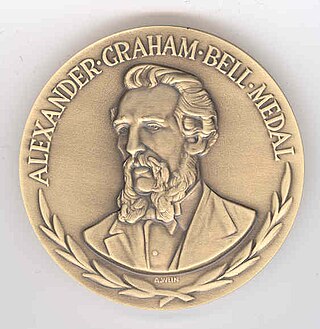
Albert Hoyt Taylor was an American electrical engineer who made important early contributions to the development of radar.

Albert Wallace Hull was an American physicist and electrical engineer who made contributions to the development of vacuum tubes, and invented the magnetron. He was a member of the National Academy of Sciences.
IEEE W.R.G. Baker Award provided by the Institute of Radio Engineers (IRE), was created in 1956 from a donation from Walter R. G. Baker (1892–1960) to the IRE. The award continued to be awarded by the board of directors of the Institute of Electrical and Electronics Engineers (IEEE), after the IRE organization merged into the IEEE in 1963. Recipients received a certificate and honorarium "for the most outstanding paper reporting original work" in one of the IEEE publications, including the transactions, journals, proceedings, and magazines of the IEEE Societies. The award was discontinued in 2016.
William Ralph Bennett Jr. was an American physicist known for his pioneering work on gas lasers. He spent most of his career on the faculty of Yale University.

Wilmer Lanier Barrow was an American electrical engineer, inventor, teacher, industrial manager, and a counselor to government agencies. He obtained a BSEE degree in 1926 from Louisiana State University, and a doctorate from the Technical University of Munich in 1931. During the pre-World War 2 development of radar at Massachusetts Institute of Technology, Barrow performed research on microwaves, inventing waveguide in 1936 and the horn antenna in 1938.
The IEEE Edison Medal is presented by the Institute of Electrical and Electronics Engineers (IEEE) "for a career of meritorious achievement in electrical science, electrical engineering, or the electrical arts." It is the oldest medal in this field of engineering. The award consists of a gold medal, bronze replica, certificate, and honorarium. The medal may only be awarded to a new leap/breakthrough in the technological area of science.

The IEEE Medal of Honor is the highest recognition of the Institute of Electrical and Electronics Engineers (IEEE). It has been awarded since 1917, when its first recipient was Major Edwin H. Armstrong. It is given for an exceptional contribution or an extraordinary career in the IEEE fields of interest. The award consists of a gold medal, bronze replica, certificate, and honorarium. The Medal of Honor may only be awarded to an individual.

The IEEE Alexander Graham Bell Medal is an award honoring "exceptional contributions to communications and networking sciences and engineering" in the field of telecommunications. The medal is one of the highest honors awarded by the Institute of Electrical and Electronics Engineers (IEEE) for achievements in telecommunication sciences and engineering.
Harald Trap Friis, who published as H. T. Friis, was a Danish-American radio engineer whose work at Bell Laboratories included pioneering contributions to radio propagation, radio astronomy, and radar. His two Friis formulas remain widely used.
Harold Alden Wheeler was a noted American electrical engineer.
Charles Stuart Ballantine was an American inventor.
Edmond Bruce was an American radio pioneer best known for creating the rhombic antenna and Bruce array.
Frederick Britton Llewellyn was a noted American electrical engineer.
Kenneth Bullington was an American electrical engineer known for his studies of radio propagation.
Ian Munro Ross FREng was an early pioneer in transistors, and for 12 years President of Bell Labs.
Stewart E. Miller was a noted American pioneer in microwave and optical communications.
Ping King Tien was a Chinese-American electrical engineer and scientist, noted for his contributions to microwave amplifiers and integrated optical circuits.
The IEEE Founders Medal is an award is presented for outstanding contributions in the leadership, planning, and administration of affairs of great value to the electrical and electronics engineering profession. It may be presented to an individual or team up to three in number. This medal was established by the Institute of Radio Engineers (IRE) in 1952. The medal continued to be awarded after the merge of the IRE with the American Institute of Electrical Engineers (AIEE) in 1963 to form the IEEE. Recipients of this medal receive a gold medal, bronze replica, certificate, and cash honorarium.
Robert W. Brodersen is a professor of electrical engineering, now emeritus, and a founder of the Berkeley Wireless Research Center (BWRC) at the University of California, Berkeley.
David Albert Hodges (1937–2022) was an American electrical engineer, digital telephony pioneer, and professor of electrical engineering at the University of California, Berkeley.




